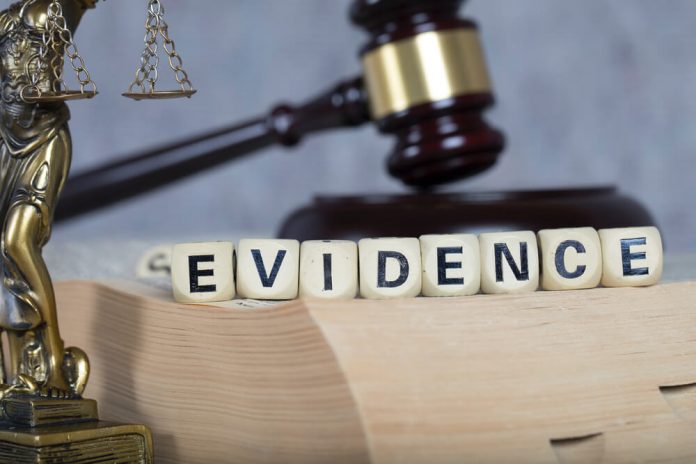This article is written by Oishika Banerji of Amity Law School, Kolkata. The article deals with a list of notable judgments surrounding the Indian Evidence Act, 1872.
Table of Contents
Introduction
The evidence law is concerned as the law of the forum, which guides, and helps the courts to reach a conclusion while dealing with a particular case. Not to be confused as proof, a piece of evidence leads the court to either prove or disprove something. The Indian Evidence Act, 1872 is an adjective law that lays down provisions to be followed by the Indian courts while accepting and determining the admissibility of evidence presented before it. The underlying principle that sets the evidence law in motion was observed in the case of Ram Jas v. Surendra Nath (1980) where it was held that the law of evidence is the law that does not affect the substantive rights of the parties instead works towards facilitating justice to the same. This article provides a list of precedent judgments that serve as a source of interpretation of the Act of 1872 by the Indian courts that can help in better understanding of the concepts of evidence law.
Landmark judgments surrounding the Indian Evidence Act, 1872
A list of case laws has been discussed hereunder that helps in understanding certain provisions of the Indian Evidence Act, 1872 that hold immense importance.
Kalyan Kumar Gogoi v. Ashutosh Agnihotri and Anr. (2011)
The Supreme Court of India in the case of Kalyan Kumar Gogoi v. Ashutosh Agnihotri and Anr. (2011) took a note of the fact as to why hearsay evidence is not considered as relevant evidence under the Indian Evidence Act, 1872. The fundamentals of the evidence law state that the hearsay evidence is inadmissible in the court of law on grounds that the same is inaccurate and vague by its very nature. As a part of its observation, the Court of law laid down certain parameters on the basis of which hearsay evidence does not hold much relevance in the eyes of law, namely;
- The responsibility on the part of the person presenting hearsay evidence stands null which ipso facto destructs the objective of the evidence law which requires every evidence presented before the court to be made with responsibility, and knowledge on the part of the individual who is providing. This is also because if otherwise happens, then the person can be accused on the grounds of falsehood by the court.
- Hearsay evidence dilutes the truth that needs to be presented before the court which thereby wastes the precious time of the court, and the other party to the case, and
- If hearsay evidence is permitted by the courts, then the same facilitates ample room for fraud, misrepresentation, and undue influence to take place, which stands unjust for the party against whom the evidence is laid down.
Roop Kumar v. Mohan Thedani (2003)
The case of Roop Kumar v. Mohan Thedani (2003) revolves around the scope and ambit of Sections 91, and 92 of the Indian Evidence Act, 1872 that has been explained by the Supreme Court of India as have been laid down in the following points;
- Section 91, as observed by the Apex Court, deals with evidence of terms of contract, grants, and other disposition of properties reduced to the form of a document thereby forbidding the proving of written contents otherwise than by means of writing only. In reality, Section 91 declares the doctrine of substantive law which holds immense importance to documentary evidence over oral ones. Thus applicable to the best evidence rule as well. As Section 91 sets limitations, it is to be noted that if a third party wants to establish a contract existing between two parties when the concerned contract has been documented, the third party can prove the same only by producing such a contract in writing. Section 92 follows Section 91 by preventing identification of oral evidence for varying a contract and therefore acting supplementary to each other, but the former differs from the latter on grounds of limitation that Section 92 imposes which in the case of Section 91 is absent completely.
- While Section 91 of the Act of 1872 with the mood of proof for the document presented before the Court, Section 92 is the provision related solely to the parties to the document.
- While Section 91 is applicable to both bilateral as well as unilateral documents, Section 92 applies only to bilateral documents.
Mangala Waman Karandikar (D) TR. LRS. v. Prakash Damodar Ranad (2021)
The recent judgment of the Supreme Court in the case of Mangala Waman Karandikar (D) TR. LRS. v. Prakash Damodar Ranad (2021) highlighted Sections 92, and 95 that deal with the exclusion of evidence of oral agreements and evidence as to document the meaning of the existing facts respectively. The issue before the Court concerned whether the provisions of Sections 92 and 95 apply to ambiguous documents or not. While observing that when the documentary terms of a contract are clear, Sections 92, and 95 will not be applicable, the Apex Court laid down the following points of determination;
- Contractual interpretations entirely depend on the intentions of the parties to the contract and the responsibility that exists on the part of the court is to provide the actual meaning that the interpretation holds.
- Judges Surya Kant and Aniruddha Bose opined that the observations given by the High Court in this present case that amplifies Section 92 beyond its legislative intent stands as a violative fundamental tenant of lawful interpretation. This opinion was made on the basis of the case of Rohitash Kumar v. Om Prakash Sharma (2012).
Bodh Raj @ Bodha and Ors v. State Of Jammu and Kashmir (2002)
Section 27 of the Indian Evidence Act, 1872 that deals with “How much of information received from accused may be proved” is nothing but a proviso to Section 25 and 26 of the Act, as has been observed by the Supreme Court of India in the case of Bodh Raj @ Bodha And Ors v. State Of Jammu And Kashmir (2002). The issue before the Apex Court in this present case has been whether the weapon used to assault that has been discovered on the reliance of the information provided by the accused in custody, be sufficient enough to fasten the guilt of the accused or not. The pronouncements made by the Court have been listed below:
- The object underlying Section 27 has been to allow certain parts of the accused statements made to the police officer to be admissible before the court as evidence whether or not such statements are confessional or non-confessional. The Court went further to state that the ban that has been imposed by Sections 25, and 26 of the Act of 1872 would stand defeated if the accused statements are related to the discovery of facts.
- It is necessary for the benefit of both the prosecution and the accused that the statements of the latter made in the custody, which is admissible under Section 27 must be proved and recorded in order to uphold the Doctrine of Confirmation which forms the essence of this provision.
- Recovery of an object and discovery of facts as explained under Section 27 are two completely different things.
- How much information by the accused will be admissible before the court of law under Section 27 depends completely upon the nature of the fact discovered in relation to such information.
Anvar P.V v. P.K.Basheer & Ors (2014)
The case of Anvar P.V v. P.K.Basheer & Ors (2014) holds immense importance in today’s technology-driven world as the Supreme Court in this noteworthy case decided on the admissibility of electronic evidence in a court of the law taking into account Section 65B of the Indian Evidence Act, 1872. By interpreting the application of provisions 63, 65, and 65B of the Act of 1872, the Apex Court, in this case, overruled its earlier decision made in the case of State (NCT of Delhi) v. Navjot Sandhu (2005), commonly known as the Parliament Attack case. The three-judge Bench of the Supreme Court comprising of Chief Justice R M Lodha, and Justices Kurian Joseph and Rohinton Fali Nariman by observing that an electronic record as a shred of secondary evidence shall not be admissible before the Court as evidence unless the requisites laid down by Section 65B are abided by, delivered the following opinions;
- Electronic documents shall be perceived as documentary evidence under Section 3 of the Indian Evidence Act, 1872.
- Any documentary evidence that is presented before the court in the form of an electronic record under Sections 59 and 65A, can only be proved in accordance with the procedure laid down under Section 65B.
- The purpose of Section 65B of the Evidence Act is to approve electronic forms as secondary evidence presented before the Indian courts. The Apex Court went further to state that it is to be noted that Section 65B begins with a non-obstante clause.
Bhimsha Subanna Pawar v. State of Maharashtra (1996)
The Bombay High Court in light of the case of Bhimsha Subanna Pawar v. State of Maharashtra (1996) took into consideration the circumstances when independent evidence is not available to the Court to carry on with the conviction of the accused. In this present case, the Hon’ble High Court while concluding that in the absence of independent evidence, the Court has to carefully examine evidence by the police witnesses which, if found to be a reliable source, will form the basis on which the conviction of the accused will exist. Thus, where assault weapons were discovered in line with the accused statement and no evidence existed which would reflect on the animosity that existed between the police inspector and the accused, it will be justified, and safe to believe the statement of the inspector which has been uncorroborated in respect of the weapon discovered.
Dr. Sunil Clifford Daniel v. the State of Punjab (2012)
The Supreme Court of India’s decision, in the case of, Dr. Sunil Clifford Daniel v. the State of Punjab (2012) concerned about the inter-relation existing between Section 162 (1) of the Code of Criminal Procedure, 1973 and Section 27 of the Indian Evidence Act, 1872. Section 162(1) reads as, “a statement made by any person to a police officer in the course of an investigation done, if reduced to writing, be not signed by the person making it”, which by its very language makes it clear that law requires a statement that has been made before the investigating officer to not be signed by the witness giving it. To simplify, the witness will not be bound by his statements made before the concerned authority. But it is noteworthy to mention that the provision of Section 162(1) of C.r.P.c will not be applicable to the statements under Section 27 of the Evidence Act. While observing this, the Apex Court noted that there lies no obligation on the part of the investigating officer to obtain the initials of an accused in the statements that have been attributed to him while preparing seizure memo under Section 27 of the Act of 1872. But if such initials have been obtained then the same will not be considered unlawful.
Arjun Panditrao Khotkar v. Kailash Kushanrao Gorantyal and Ors (2020)
Another relevant case that appeared before the Supreme Court of India in relation to Section 65B was the case of Arjun Panditrao Khotkar v. Kailash Kushanrao Gorantyal and Ors (2020). The three-judge bench of Justices Rohinton Fali Nariman, S. Ravindra Bhat, V. Ramasubramanian observed that it has been a settled legal principle that the Evidence Act prohibits the proof of an electronic record by means of oral evidence if the requirements provided under the statutory provision of Section 65B of the Act are not complied or abided by. Establishing the friendly connection between the Information Technology Act, 2000 and the Indian Evidence Act, 1872, the Court held that Section 65B of the latter has been a complete Code by itself, and therefore the former legislation and the statutory provision of the Evidence Act behaves as legal machinery against technological overpowering.
Conclusion
With technology overpowering human intelligence, Section 65 B of the Indian Evidence Act, 1872 that concerns the admissibility of electronic evidence and was inserted in the statute by means of Indian Evidence (Amendment) Act, 2000, has been in discussions in a recent line of cases. With the decision made concerning the admissibility of electronic evidence by the Supreme Court of India as has been discussed previously, the importance of evidence law in recent times can be taken into account. Evidence law is a branch of law that has received importance through time immemorial and therefore, it is only through notable judgments delivered by the judiciary that the purpose underlying the provisions of the Indian Evidence Act, 1872 can be acknowledged.
References
- https://www.jstor.org/stable/43950171
- https://www.legalserviceindia.com/article/l136-Circumstantial-Evidence.html
- http://mja.gov.in/Site/Upload/GR/Title%20NO.140(As%20Per%20Workshop%20List%20title%20no140%20pdf).pdf
Students of Lawsikho courses regularly produce writing assignments and work on practical exercises as a part of their coursework and develop themselves in real-life practical skills.
LawSikho has created a telegram group for exchanging legal knowledge, referrals, and various opportunities. You can click on this link and join:
https://t.me/joinchat/J_0YrBa4IBSHdpuTfQO_sA
Follow us on Instagram and subscribe to our YouTube channel for more amazing legal content.
 Serato DJ Crack 2025Serato DJ PRO Crack
Serato DJ Crack 2025Serato DJ PRO Crack










 Allow notifications
Allow notifications



